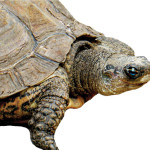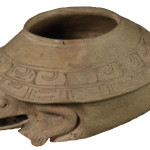Sacred turtles in Mayan art and iconography
A new FLAAR Report* now lists all of the animals that were sacred or otherwise considered as special by the Classic Maya. There are animals that are related to the sky (constellations, stars, planets), the forests and those that are associated with rivers, lakes, swamps and the oceans. These waters are conflated by the cosmology of the Preclassic and Classic Maya into the underwaterworld.
On the surface of this underwaterworld you get the major interaction of exotic creatures. Crocodiles, fish, sharks, turtles—both sea turtles and freshwater turtles—are often depicted.
It has long been recognized that turtle carapaces were used as musical instruments. These instruments are pictured in murals and on pottery vases, especially in the Late Classic period (AD 600-800).
The turtle carapace scene shows a youthful deity figure splitting out of a sea shell on a plate. This resurrection from a giant turtle carapace is one of the truly important moments in Mayan cosmology.
The carapaces of turtles are often depicted in Mayan art as one of the housings of God N (also called Pauahtun). Normally God N is in a conch shell or snail shell, but sometimes he can be in a turtle carapace.
Turtles are found in the various Mayan codices and in the murals of Bonampak. Any good book on Mayan archaeoastronomy will discuss the turtles (and peccary) in the murals and codices. Turtles are decoration for a typical Puuc structure at Uxmal in the Yucatán. Turtle symbolism is deeply embedded in Classic Maya beliefs.
Dr. Nicholas M. Hellmuth is director of FLAAR Reports (Foundation for Latin American Anthropological Research). To view the list of sacred animals visit www.maya-archaeology.org or contact Dr. Hellmuth at frontdesk@flaar.org
* See the complete list of sacred animals at www.maya-archaeology.orgTurtles that you can find in the rivers, lakes and mangrove swamps of Guatemala, southern Mexico or Belize include: Central American river turtle tortuga blanca, Dermatemys mawii; Furrowed wood turtle, rhinoclemmys areolata; Mexican snapping turtle, Chelydra serpentina; Narrow-bridged musk turtle, Claudius angustatus; Northern (Mexican) giant musk turtle, Staurotypus triporcatus, three parallel ridges along back; Red-eared terrapin, Mesoamerican slider, jicotea, Trachemys scripta; Scorpion mud turtle, Kinosternon scorpioides; Tabasco mud turtle, Kinosternon acutum; White-lipped mud turtle, Kinosternon leucostomum; Creaser’s mud turtle, Kinosternon creaseri; Yucatan box turtle, Terrapene carolina.

